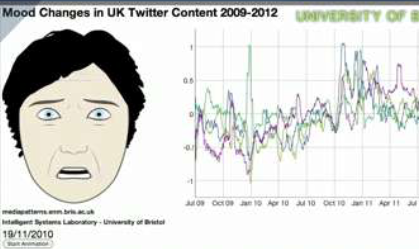Twitter’s 140 character limit is superb for sending out short bursts of information, but also can it be useful in assisting us to gauge what public is feeling and in which mood they are?
Researchers at the University of Bristol in the U.K. Carried out a study to test this hypothesis. From July 2009 to January 2012, they examined 484 million tweets generated by nearly 20 million users. And with that research they found that the twitter did match up with British public beliefs.

The researchers found a compelling increase in negativity, annoyance and fright around two events mainly- in October 2010, which accompanied with the government’s declaration of public spending cuts, and last summer, when riots rocked the streets of major U.K. cities.
Of course, public opinion changes and the researchers found a comparative calm in the tweets during last year’s royal wedding between Prince William and Kate Middleton, which made a global news.
“While we leave the interpretation of our findings to social and political scientists, we observed how the period preceding the royal wedding seems to be marked by a lowered incidence of anger and fear, which starts rising soon after that,” said Professor of Artificial Intelligence Nello Cristianini. “Of course, other events also happened in early May 2011, so they may also be responsible for that increase.”
The researchers also revealed the restraints in their research. To examine social media content, they utilized text mining technologies, which, however can be employed to huge amounts of data, are less precise than assessments by humans.

Also, a Twitter-based study is clearly preconception toward Twitter users and not everyone makes use of this micro-blogging site. Unconcerned, these findings do make some sense. People use Twitter to post all sorts of things, from their personal opinions to latest happenings to — and yes, their feelings.
And if you are really interested in knowing what people are wishing, thinking, loving, feeling, hating, believing right now, check out the real-time results coming out of Twistori.
Do you think we’ll continue to find correlations between Twitter and the public mood? Let us know in the comments.
